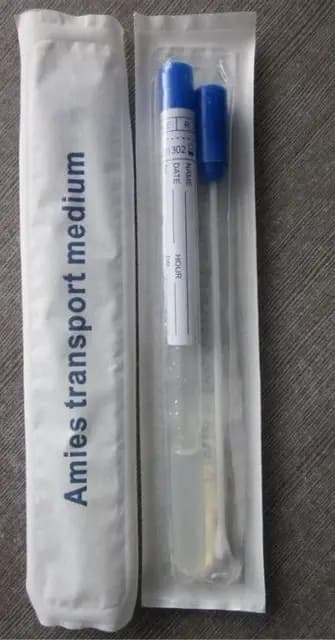Content :
Amies Transport Medium: Principles, Preparation, and Application
◉ Preview
Amies transport medium is a semi-solid medium recommended for the collection, transport, and qualitative preservation of clinical specimens, as well as for their long-term frozen storage. This medium is formulated to maintain the viability of microorganisms without promoting significant growth.
Introduced by Stuart et al. in 1954, Amies medium is a modification of Stuart transport medium. The main difference is the replacement of glycophosphate with an inorganic phosphate buffer and the addition of activated charcoal, thus improving the survival of microorganisms such as Neisseria gonorrhoeae.

Amies Transport Medium
◉ Composition and preparation
Composition
| Ingredients | Quantity (g/L) |
|---|---|
| Sodium chloride | 3.0 |
| Potassium chloride | 0.2 |
| Dipotassium phosphate | 0.2 |
| Disodium phosphate | 1.15 |
| Magnesium chloride | 0.1 |
| Calcium chloride | 0.1 |
| Sodium thioglycolate | 1.0 |
| Agar | 4.0 |
| Charcoal (optional) | 10.0 |
| Demineralized water | 1000 mL |
Preparation
- Suspend the dried powder components in purified or distilled water (20 g in 1000 mL).
- Bring to a boil while stirring to completely dissolve the medium.
- Pour the solution into small screw-capped bottles, stirring to maintain a uniform suspension of the charcoal.
- Sterilize the bottles in an autoclave at 121°C for 15 minutes.
- Invert the bottles as they cool to distribute the charcoal evenly.
- Store the bottles in a cool place.
◉ Principle
A transport medium must be non-nutritive, semi-solid and reducing to limit self-destructive enzymatic reactions. Amies medium meets these criteria thanks to its specific components:
- Sodium thioglycolate: Creates a reduced environment, thus preserving the viability of microorganisms.
- Activated carbon: Neutralizes toxic substances that may harm sensitive pathogens, such as Neisseria gonorrhoeae.
- Salts: Improve cell survival by controlling the permeability of bacterial membranes.
- Phosphate buffer: Maintains the stable pH of the medium.
◉ Instructions for use
Insert a sterile swab containing the specimen into the upper third of the prepared transport medium.
Break off the protruding portion of the swab and tightly screw the container cap on.
Send the specimen to the laboratory within 24 hours for culture analysis.
If necessary, refrigerate the specimen until shipping.
Clinical Applications
Amies medium is particularly useful for the transport of fastidious microorganisms such as Neisseria gonorrhoeae, Streptococcus pyogenes and Haemophilus influenzae. It is also suitable for cervical, nasal or pharyngeal swab samples.
Precautions
- Handle with care to avoid cross-contamination.
- Use sterile equipment and follow current biosafety procedures.
- Store vials in optimal conditions to maintain their potency.
Limitations
Amies medium is not suitable for certain microorganisms requiring highly nutritious or specific media. A prior assessment of the pathogens' needs is recommended.